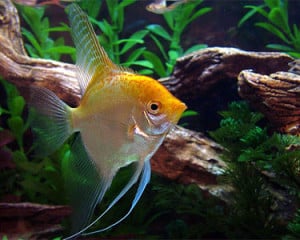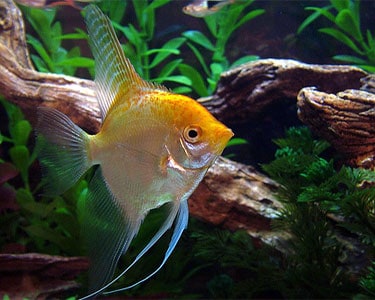
Common Name: Gold Veil Angelfish, Gold Veil Angel
Scientific Name: Pterophyllum sp
Average Adult Fish Size: 6 inches / 15.2 cm
Place of Origin: Amazon river basin of S. America
Typical Tank Setup: Well planted with drift wood / bogwood and some rock work.
Recommended Minimum Aquarium Capacity: 30 gallon / 120 litre for an adult pair
Compatibility: Keep with medium sized peaceful fish that do not like to nip fins. Angels will eat smaller fish as they are an ambush predator in the wild.
Temperature: 24-29 Deg C / 76 – 84 Deg F
Water Chemistry: pH 6.5 – 6.9 for wild varieties. Captive raised can be successfully kept in ph up to 7.8.
Feeding: Angels will readily accept flakes, small pellets, frozen and live foods. Veil-tailed varieties are rather slow moving, so make sure that they get their fair share of food.
Sexing: It is usually very hard to distinguish a female Angel from a male one, since they look almost identical. An egg laden female will be thicker with a pronounced bulge, and a male will normally be thinner and “taller”, but most Angelfish keepers are actually unsure of the sex of their fish until they notice which one is laying the eggs and which one is fertilizing them. Venting is the other sure way to determine gender.
Breeding: Your Scalare will usually need to become at least 5 cm / 2 inches before they are mature enough to spawn for the first time. If kept on a suitable diet, this will happen when the Angelfish is between 8 and 12 months old. The aquarium should ideally be at least 40 cm / 16 inches high. Since the Angelfish is a tall fish, an aquarium that is too shallow will stunt their growth. Adequate water changes need to be performed and water temperature kept between 80 and 85 degrees F (27 and 29 degrees C) in order to stimulate breeding.
Suitable food is also necessary to get your Angelfish into spawning condition. The diet should be varied. Prepared foods especially made for Angelfish is a good base, but should be supplemented with meaty foods. Mosquito larvae, daphnia, beef heart, brine shrimp and large market shrimp cut up into suitable size are food types known to induce spawning in Angelfish. When Angels are in proper condition, and water parameters are to their liking, they will lay their eggs on almost any flat vertical surface like Amazon Swords, a piece of slate, aquarium glass, uplift tubes, or the like.
Several methods are used by Angelfish breeders to protect eggs and fry from hungry adult fish. Some remove all fish except the breeding pair from the aquarium, while other breeders choose to remove the breeding pair, and transfer them to another tank.
All adult Angelfish pose a threat to the eggs, and many breeders will therefore place the eggs in their own tank as soon as the eggs have been fertilized. The easiest way is to put a special spawning slate in the aquarium before the spawning takes place. The parent fish will deposit the egg on the spawning slate, and the spawning slate can be easily moved afterwards. A clay pot, poly pipe or a piece of smooth surfaced tile will all work as spawning slates. The eggs will survive a brief moment out of the water when you lift them from one aquarium to the other, but try to make the move as fast as possible.
If you do not wish to keep all your fry, you can let the eggs stay in the aquarium with the adult fish. If you provide your fry with suitable hiding places, such as heavily planted areas, at least a few of them will reach adulthood. Be aware of strong filtration, since small fry can be sucked into filter systems.
If your Angelfish pair has never spawned before, it is usually a good idea to let them spawn once or twice in their normal aquarium “on their own” without your meddling. If you move them to a breeding aquarium during their first spawning they might be confused and stop the spawning process. It is normal for the parents to eat the eggs from their first spawning, and if this happens the female will usually deposit eggs again after just a few weeks.
If the eggs are not fertilized, they will start turning white after approximately 24 hours. If they have not been eaten by other inhabitants of the aquarium, unfertilized eggs will be attacked by fungus and start looking very fuzzy after roughly 48 hours. 48 hours after being deposited, fertilized eggs on the other hand will begin showing wiggling fry tails. On day three, tadpole shapes with large yolk sacks will be visible. The tadpoles will still be attached to the breeding slate. If the parent Angelfish are still in the same aquarium as the egg, the parents will now start to move the small fry around. On the fourth day you will be able to see tiny eyes on the fry and on the fifth day the yolks will start shrinking. Very soon the first fry will be free swimming. During day seven the fry will usually start getting hungry since their energy from the yolk have been consumed.
You can start feeding your Angelfish fry around 7 days after the eggs were deposited. Angelfish fry can survive 12 hours without food, but should ideally be fed four or five times a day. Newly hatched Brine Shrimp (Artemia nauplii) are a good first food for Angelfish fry. If the fry is too small to consume the Brine Shrimp, you can buy the fry special fry food from a pet shop or fish store. The survival rate for Angelfish fry is usually very much lover when the fry is fed dead food instead of live food (such as live Brine Shrimp). When the fry are a few weeks old it is time to get them accustomed to flake foods. Turn the flake food into a powder or press it through a fine screen before feeding it to the fry.
Additional Information: Gold Veil angelfish are relatively fragile when smaller. Good water quality along with frequent water changes and a varied diet is the key. Adults are generally hardy while juveniles can be quite fragile.


Related Posts
Croaking Gourami – Trichopsis vittatus
Paradise Fish – Macropodus opercularis
Schubert’s Barb – Barbus Semifasciolatus